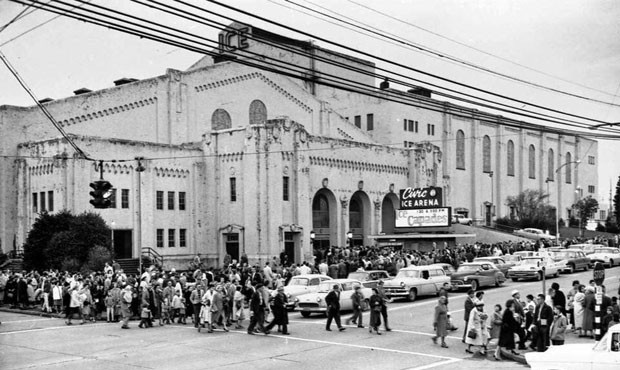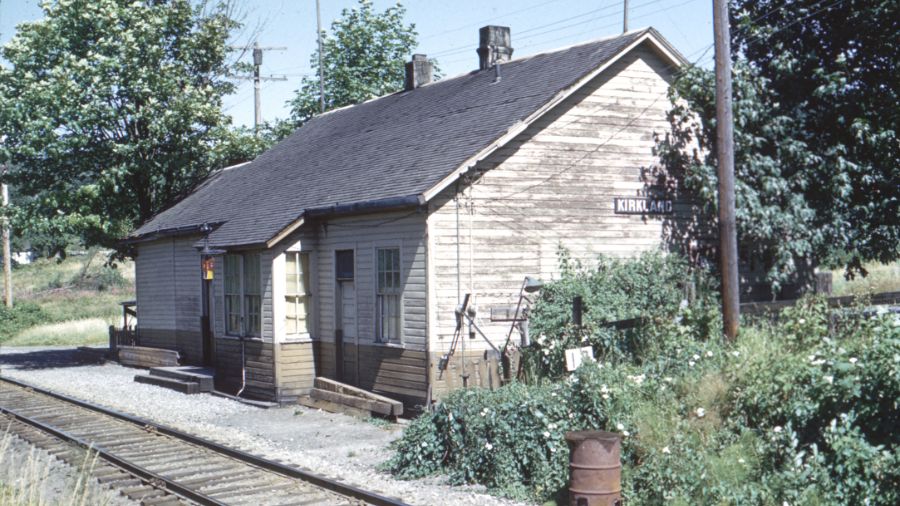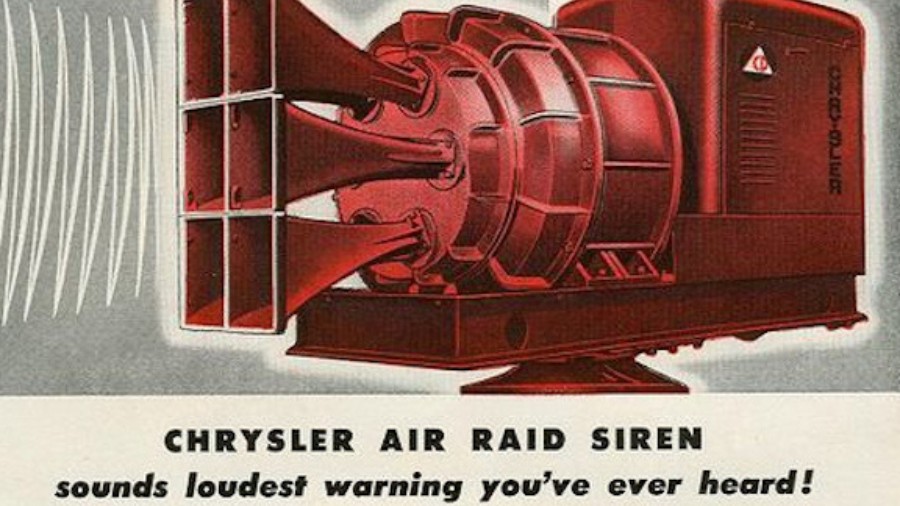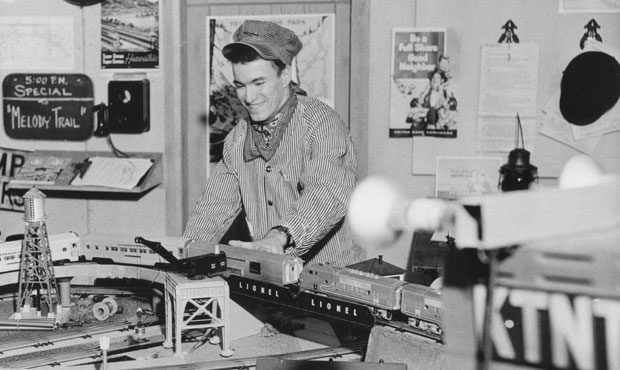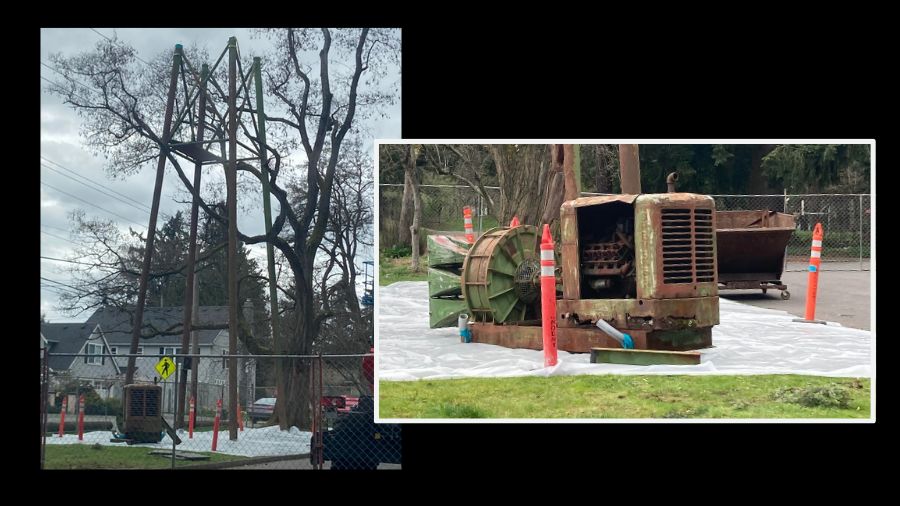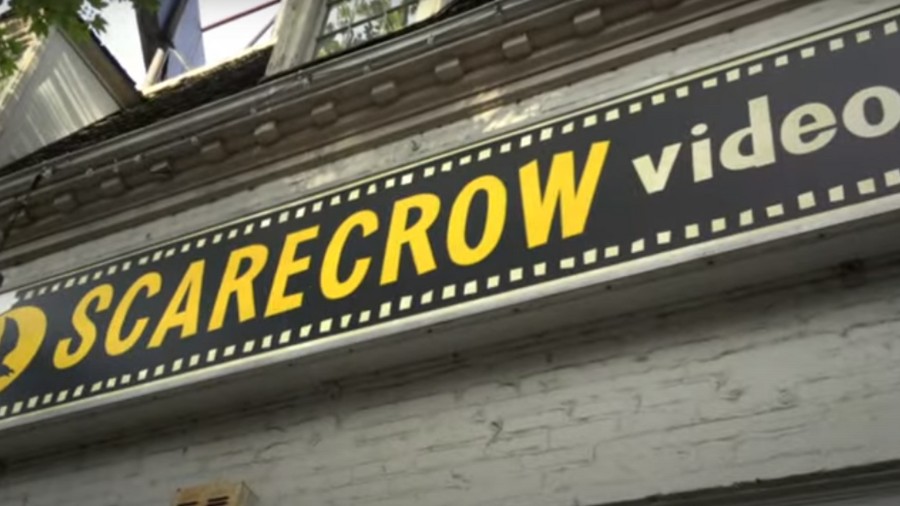Ornate hidden past of Seattle Center’s ‘orphan’ arena quietly being demolished
Mar 22, 2017, 6:43 AM | Updated: Aug 27, 2019, 10:13 am
UPDATE:
The Seattle Opera said Friday that they will take time to document what remains of the north wall of the original 1928 Civic Arena at Mercer Street and Fourth Avenue North.
Demolition crews revealed the wall, along with nearly all of its original ornate decoration intact, late Thursday morning.
Passersby who were gathered on the sidewalk across Mercer Street from the site watched as heavy equipment tore down a brick wall built in 1961 that revealed much of the 1928 facade. Within moments, the heavy equipment was then used to tear at several intact elements from the original building, including two concrete gargoyles roughly three feet high, atop columns on either side of the old doorways.
KIRO Radio had first contacted Seattle Opera last week with questions about what might remain of the old building. The original 1928 structure was clad in brick in 1961 to modernize its look in preparation for the 1962 World’s Fair.
Meanwhile, Seattle Opera’s Kym Michela said in an email Friday, “We were not aware of the condition or full existence of the 1928 structure . . . Seattle Opera is using a pause in the demolition schedule to document the north wall and have historical photographs taken for archival purposes.”
Late Friday, an official from the Seattle Opera said via email, “We are going to try to save the remaining two gargoyles when we get started [with the demolition] again next week.”
–Original story–
It’s been headline news lately that Seattle Center’s KeyArena is once again a possible alternative to Chris Hansen’s proposed SoDo sports and event facility as a local home for hockey and/or basketball.
Related: Sidewalk artifact is relic of forgotten Seattle company
Meanwhile, Seattle’s original public arena – also at Seattle Center – is quietly in the middle of being demolished. Work began earlier this month, and is expected to wrap up in May.
The building that’s coming down was known for much of its life as the Civic Arena or Civic Ice Arena, and then the Seattle Center Arena. It’s on the corner of Mercer and 4th Avenue North, between McCaw Hall and the KCTS building. Once it’s out of the way, Seattle Opera will build a new headquarters on the site.
The Civic Arena was originally built in the late 1920s as part of a complex of public facilities that included an outdoor ball field where Memorial Stadium now stands (and where Seattle’s Pacific Coast League Baseball team played for many years); a Veterans Hall (where the old Doughboy statue stood); and the Civic Auditorium, which was later converted to the Opera House for the 1962 World’s Fair, and then renovated as McCaw Hall in 2003.
The Civic Arena could seat about 5,000. It shared a common wall and was perpendicular to the Civic Auditorium next door, which seated nearly 3,000. Both structures were built in what architects call the “Romanesque Revival” style, with arched doorways and ornate yet restrained trim along the rooflines and around windows.
From 1928 to 1961, the Civic Arena was the major public indoor sports and event venue in town, although Hec Ed Pavilion on the UW campus was similar in size and hosted some similar events. But the Civic Arena had a couple important advantages over Hec Ed: it was close to downtown, and it had an ice rink for skating, hockey and ice shows.
In 1961, as part of the work to create the 1962 World’s Fairgrounds, the Civic Arena and Civic Auditorium complex got a facelift, with interior improvements and a major resurfacing of the exterior walls on the north side along Mercer, and on the east side along 4th Avenue. It was a brilliant form of recycling and reuse, long before it was fashionable.
Construction of a long portico (or covered walkway) and supporting colonnade (row of columns) served to physically and visually connect all of the World’s Fair facilities on Mercer, including the Arena, what became the Opera House, and the newly-constructed Exhibition Hall and Playhouse. These changes were designed by a local architect named Paul Hayden Kirk, who also designed the big parking garage on the north side of Mercer Street.
During the six-month fair – arguably the most significant positive event in the city’s history – the Arena hosted acts such as Lawrence Welk, the Ringling Brothers Circus, the Shrine Circus, Ice Follies, Century 21 Horse Show and the Mormon Pageant.
In the years after the fair, the Arena lost a little of its luster because what was then called the Coliseum soon came online as a sports venue (for the Sonics of the NBA and for countless other events) and as a place for big concerts, including the Beatles and Rolling Stones. Even so, the Arena remained a reliable venue well into the 1990s for ice shows, amateur and professional hockey games, high school and college graduations, professional wrestling, and concerts by artists such as the Kinks, J. Geils Band, Stray Cats and The Cure.
In 1995, when the Coliseum was officially renamed KeyArena, “Mercer” was added to the old Arena name to minimize confusion. Some time after that, the facility became known as Mercer Arts Arena. During transformation of the Opera House to McCaw Hall in the early 2000s, the Mercer Arts Arena interior was modified as a temporary venue for performances by Pacific Northwest Ballet and Seattle Opera.
Since the early 2000s, the building has been home to Seattle Opera for back-of-house rehearsal and storage space. Thus, for almost 15 years, no ticketed public events have been held in the Arena, and the existence of it seems to have dropped off of nearly everyone’s radar.
And this is likely part of the reason that nobody seems to care much that the building is now coming down, says David Rash, a local architectural historian.
Rash has researched and written about the original Civic Auditorium and Civic Arena complex, including authoring entries in the recent UW Press publication “Shaping Seattle Architecture: A Historical Guide to the Architects” about the architecture firm (Schack, Young & Meyers) who designed the Arena (among other structures) and Paul Hayden Kirk, who designed the 1961 changes.
“There isn’t a lot of concern about [the Arena] being destroyed because it hasn’t been part of the civic infrastructure, and the type of facility that’s had people coming on a regular basis, ever since the World’s Fair,” Rash said. “And so if something is under-utilized to [this] extent . . . it’s not surprising that people don’t necessarily care that it’s being destroyed.”
Rash says the Arena is something of an “orphan” — it has no built-in constituency of regular users or devoted fans to speak up for it because it’s been offline for so many years.
This “orphan” feeling for the Arena even prevails in parts of the local preservation community.
Contacted for this story, Eugenia Woo of preservation group Historic Seattle said in an email, “The demolition is unfortunate, but I have never been inside and do not know that much about the building as compared to the other structures at Seattle Center. Historic Seattle has to prioritize its advocacy efforts. We have no formal statement about this property.”
Officials at the City of Seattle Landmark Preservation Board said that no one advocated on behalf of preserving the Arena last year when its historic significance was reviewed as part of the process to secure a demolition permit.
In a letter to Seattle Center officials dated July 16, 2016, Tom Quackenbush of the Department of Neighborhoods (where the Landmark Preservation Board is housed) wrote: “[W]e have determined that it is unlikely that the Mercer Arts Arena would meet the threshold standards for designation as an individual landmark, due in large part to the loss of its historic context.”
Related: Civil War General George McClellan failed in the Cascades
Quackenbush acknowledged “the significant history associated with the Mercer Arts Arena building” over its many decades of existence, but concluded “[u]nfortunately, the renovations to the exterior of the McCaw Hall Opera House have isolated the Mercer Arts Arena from the remaining and largely intact World’s Fair buildings, so that the Mercer Arts Arena is unlikely to have the ability to convey its significance.”
But there’s at least one question for which there is not yet a satisfactory answer: How much of the original 1928 building – with all that now very distinctive Romanesque Revival decorative trim – is simply hidden behind the 1961 brick wall on the north and east side?
Expediency and thrift likely meant that those features were left in place and simply covered up when the work was done just prior to the World’s Fair. Do peekaboo views of original decorative trim on the south side of the building (from Memorial Stadium) mean there’s more hiding behind the newer brick?
Nobody seems to know for sure. Seattle Center staff doesn’t know. Historic preservation experts don’t know. Seattle Opera couldn’t say with certainty, and their spokesperson said the demolition contractor on the project wouldn’t allow a reporter in to take a closer look. Adding to that old “orphan” feeling, almost everyone contacted for this story hadn’t set foot in the Arena since the 1980s.
David Rash is fairly certain about how much of the old 1928 building remains, and, with the building nearing its final curtain call, he’s also able to put the loss into historical perspective.
“The basic structure is probably still there. The trusses. The roof deck is still there, just like it is with McCaw Hall,” Rash said.
“But just like McCaw Hall . . . it’s very difficult to imagine what that building looked like prior to the World’s Fair. And what it looked like after the World’s Fair is very simple,” Rash said, “and it would be very difficult to say that the remodeling was a significant work by Paul Kirk and his firm.”
“It was simply something that needed to be done to make that building match the rest of the fair,” Rash said.
As work to dismantle the old Arena continues along Mercer over the next few months, it will be interesting to see what the demolition crews uncover when those 1961 brick walls come down.

